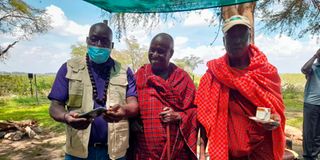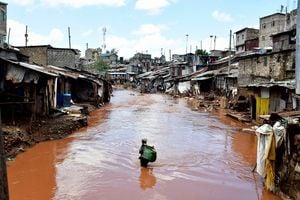New way of making man, wildlife co-exist

It’s a unique thing to drive through Amboseli National Park, located near Mount Kilimanjaro, bordering Kenya and Tanzania, and not miss the sight of a herd of cattle grazing. And just 100 metres afterwards, there is a herd of elephants roaming beneath the mountain.
This is the norm in Amboseli, Kajiado County, where locals coexist with animals, sharing the available resources; from water to pasture. It is also one of the best places in Africa to view large herds of elephants up-close.
Amboseli is one of the few parks in Kenya with no electric fence. This makes the wild animals roam freely within and outside the park, commonly referred to as a protected area.
Mr Daniel Loturesh knows this too well. He is the chairman of Olgulului Ololarashi Community Ranch in Amboseli. He, together with thousands of members of his community, gave out 26,000 acres of their land, known as communal ranches, to be a wildlife habitat in 2013.
Instead of selling the land to potential investors who would have set up industries, distracting the animals, they leased the land to the International Fund for Animal Welfare (IFAW), a global conservation organisation that aims to ensure the protection of wild animals through coexistence with humans.
“We have learnt over the years to live with the animals and we do not see them as harmful. We have also seen the benefits they have had in our lives,” Mr Loturesh told Healthy Nation during an interview in Amboseli.
He explained that in return, other than receiving payments yearly for leasing the land, they benefit from job opportunities, education scholarships, access to clean water and improvement of infrastructure such as roads. To protect themselves and livestock from getting harmed by animals such as lions, the Maasai homesteads and cowsheds are fenced with dry thorny bushes, which makes it difficult for wild animals to get through.
Recently, baffled by the way locals in Amboseli live with animals, two chiefs from Malawi and Zimbabwe, whose communities neighbour Kasungu National Park and Hwange National Park, respectively, visited the Amboseli to learn how the animals co-exist with locals.
“Driving through the park after we landed at the airstrip, we were shocked to notice herders in the park and at the same time spot wild animals. This is impossible in Malawi – when we see wild animals such as an elephant, we see a delicious meal and we want to kill it the next minute ” said senior chief Felix Lukwa of Kasungu area in Malawi.
He was speaking during a meeting attended by his Zimbabwean counterpart, Chief Siphoso Alphius Msindazi of the Tshosholotso community, together with traditional leaders from the indigenous Maasai community, which was to discuss real-life challenges faced by their communities and to explore solutions that will chart the way for successful human-wildlife co-existence. They are expected to replicate the same in the southern African countries.
So, what is the importance of involving traditional leaders in conservation?
Conservationists have for years stressed the need of involving indigenous communities in key decision making, even more than government officials in matters involving protection of wild animals in parks.
“It works better if the talks begin from the grassroots level. So, all leaders should always start with us here. It took a lot of effort to convince people to lease their land eight years ago, so we had to hold many meetings with them without the government and other organisations,” said Mr Loturesh.
IFAW President and CEO Azzedine Downs, whose organisation works closely with the Maasai in Amboseli, as well as communities in Malawi and Zimbabwe, said over the years they have seen what role traditional leaders play in the conservation and protection of animals.
“It is the community that first comes into contact with poachers and any other threats to wild animals, and they have the power to report them,” said Mr Downes.
He said wildlife, in the case of Amboseli, spend 90 per cent of their time outside the park boundaries and in the community land.
Mr Downs added that similar meetings like the one held in national parks are set to continue, targeting all communities across Africa that live near national parks.
“We cannot do this (conservation) without community support. This meeting of influential chiefs might be the first, but it will not be the last. We want to create lasting connections and even long-term friendships across Africa that lead to happy co-existence of communities and the wildlife with which they share their lives,” he said.
The plan is part of their newly launched Room to Roam initiative, a conservation strategy that seeks to accord wild animals enough space to enable them to move to different areas and also migrate without any barriers or facing any threats. This is also under plans to ensure adaptation of climate change, which has affected livelihoods in parts of Africa.
“IFAW is working with several partners and stakeholders to prioritise future conservation efforts that account for the anticipated negative effects of climate change," he said. He cited wildlife protection, land use planning and restoration, community engagement and research that will result in effective management of habitats, enabling animals to roam from Southern to East Africa.
The organisation plans to secure 29,000 more acres of land in addition to the 26,000 that were leased to them as conservancies in 2013 by Maasai communities to enable the free movement of animals.
This is aimed at reconnecting habitats of elephants and other wildlife to roam and prevent them from crowding in one country.
He further lauded Kenya for being ahead of most African countries in terms of conservation efforts that are led by community leaders.
In a move to boost its conservation efforts, Kenya recently conducted an inaugural wildlife census. The results were released in September.
"The report arising from this noble national effort provides the required information to guide future conservation and management of our wildlife resources in a manner that minimises human-wildlife conflict and also promotes sustainable development," President Uhuru Kenyatta said during the launch of wildlife census results in Nairobi.
For Mr Loturesh, he believes his next generation will also take the same approach of conserving wild animals and protecting nature while gaining from it.





